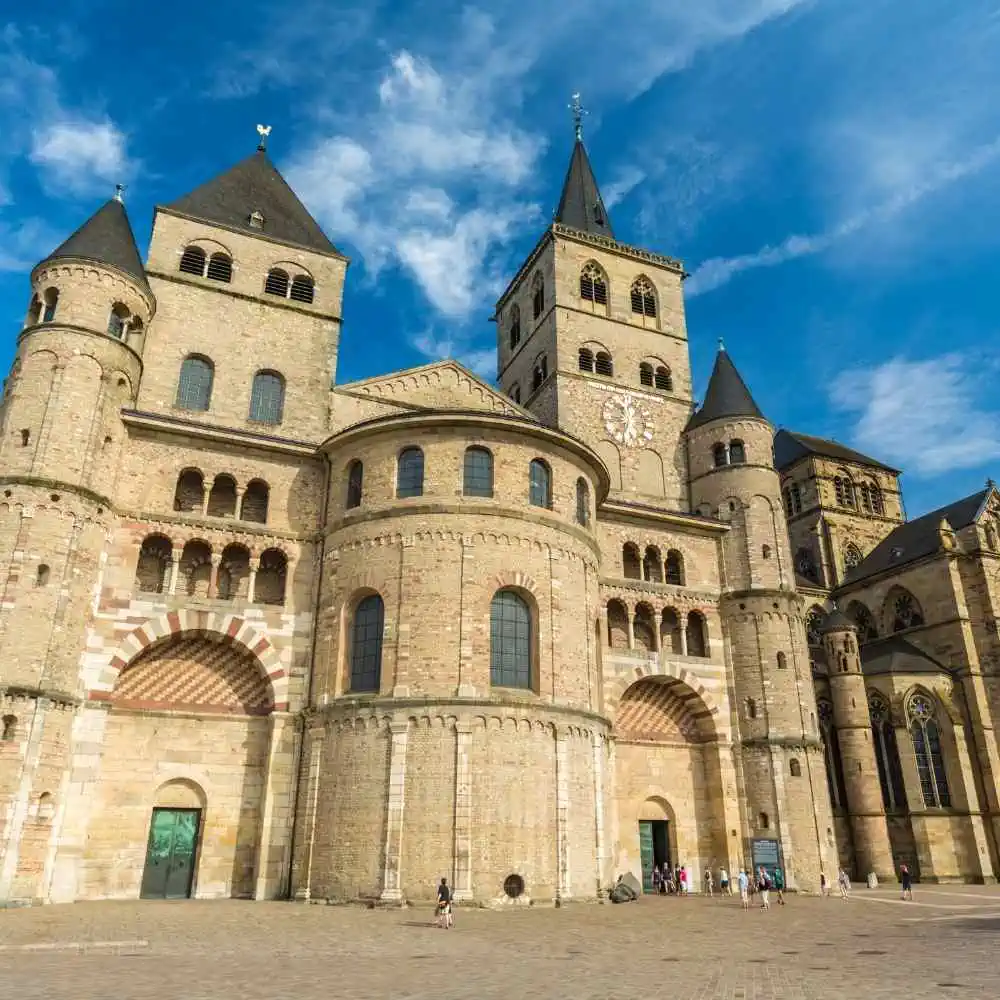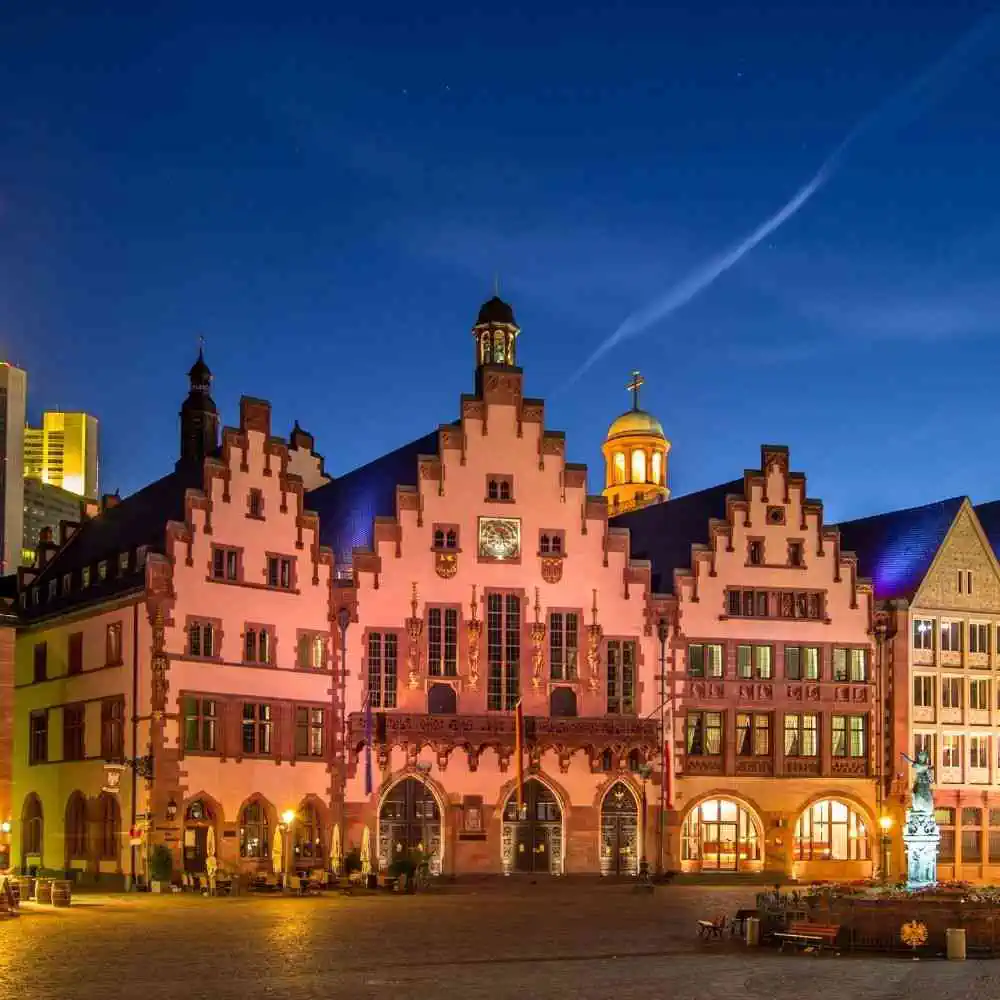Wyruszysz z Frankfurt (Main) Hbf, położonego w samym centrum miasta Frankfurt nad Menem, i będziesz cieszyć się pięknymi widokami podczas podróży, aż dojdziesz do Trier Hbf, które również znajduje się w sercu Trier.
Pociągi z Frankfurt nad Menem do Trierod € 25.00
Pociągi z Frankfurt nad Menem do Trier
Podróżowanie pociągiem: Frankfurt nad Menem - Trier
A Journey from Frankfurt-am-Main to Trier: Exploring Germany on a Train Trip!
Adventurous travelers seeking to explore Germany should consider a train trip from Frankfurt-am-Main to Trier. This exciting journey includes stops at many iconic locations such as Mainz, Koblenz, and Bingen, and the whole trip takes approximately four hours and twenty-five minutes. The total distance between the two cities is 155 miles, making it a great option for those looking for a quick and easy way to get from Frankfurt to Trier.
The journey starts with a train ride from Frankfurt-am-Main to Mainz, located 10.7 miles away. This is a great opportunity for travelers to admire the stunning views of Germany's countryside while passing through famous cities like Wiesbaden and Rüsselsheim en route. Once in Mainz, travelers can explore Germany's oldest city and take in the city's quirky mix of historical and modern attractions.
The next stop in the journey is Koblenz, located 46.7 miles away. This picturesque city is surrounded by lush greenery and charming rivers. While here, travelers can experience some of Germany's cultural heritage with a visit to the majestic Ehrenbreitstein Fortress, situated on a hill overlooking the Rhine and Mosel rivers. Another popular attraction is the Deutsches Eck, a monument made up of two stone eagles watching over the confluence of two rivers.
The final stretch of the journey from Koblenz to Trier takes travelers another 55 miles through the Rhineland-Palatinate region of Germany. As the train passes through Bingen, travelers have the unique opportunity to take in the breathtaking sceneries of the Rhine Valley. Once in Trier, travelers will be greeted by the beautiful city of Romanesque architecture, home to one of the oldest churches in Germany - the Porta Nigra.
The journey from Frankfurt to Trier by train is a great way to explore Germany's beautiful countryside, its iconic historical sites, and its incredible cities. Whether travelers are looking for an adventure, a romantic getaway, or just some downtime, this four-hour train ride offers the perfect opportunity to experience all the beauty and charm that Germany has to offer, with plenty of time to spare.

Szczegóły podróży
How long does the train from Frankfurt to Trier take?
The fastest train from Frankfurt to Trier takes approximately, 2h 10m although some high speed trains can reduce the total travel timeHow much does the train cost from Frankfurt to Trier?
The cost of a train ticket from Frankfurt to Trier varies depending on the type of ticket, class, fare and the route. Generally, a one-way ticket starts from € 25.00. It is recommended to search the prices to get the best deals.How much does the Frankfurt to Trier?
There are direct trains from Frankfurt to Frankfurt. What is the distance between Frankfurt and Trier by train? The distance between Frankfurt and Trier by train is 200km (124 Mi) Which is the main train station for Frankfurt Frankfurt main station is Frankfurt Main Hbf located right in the heart of the city of Frankfurt Which is the main train station for Trier Trier main station is Trier Hbf located right in the center of the city of TrierFrankfurt nad Menem: Miejsca do zobaczenia
Frankfurt am Main, serce finansowe Niemiec, zachwyca swoją dynamiczną mieszanką nowoczesności i bogatej historii. Zastanawiasz się, co sprawia, że ten miasto jest tak niezwykłe? Odkryj jego architektoniczne cuda i kulinarną różnorodność, które czekają na każdym kroku.
Römer
Niewątpliwie serce historycznego Frankfurtu, plac Römerberg z zabytkowym ratuszem Römer, jest miejscem, które nie może umknąć Twojej uwadze. Lokalizacja: Römerberg, Godziny otwarcia: dostępny publicznie, Opłata za wstęp: brak. Jego fasady odbudowane po zniszczeniach II wojny światowej są świadectwem niemieckiej determinacji.
Katedra św. Bartłomieja
Ta imponująca gotycka katedra, znana również jako Kaiserdom, to nie tylko miejsce koronacji cesarzy, ale i symbol wytrwałości. Lokalizacja: Domplatz 1, Godziny otwarcia: 9:00-17:00, Opłata za wstęp: brak. Wspinaczka na wieżę zapewnia niezapomniane widoki na miasto.
Stary Most Żelazny
Eisenbrücke, z jego charakterystyczną żelazną konstrukcją, oferuje malowniczy widok na rzekę Men i skyline Frankfurtu. Lokalizacja: nad rzeką Men, Godziny otwarcia: całą dobę, Opłata za wstęp: brak.
Wieża Main Tower
Wchodząc na Main Tower, znajdziesz się na jednej z najwyższych platform widokowych Europy. Lokalizacja: Neue Mainzer Str. 52-58, Godziny otwarcia: 10:00-21:00, Opłata za wstęp: €7,50. To idealne miejsce, aby zobaczyć miasto z lotu ptaka.
Paulskirche
Kościół św. Pawła, znany z historycznej roli w demokratyzacji Niemiec, dzisiaj służy jako miejsce wystaw i wydarzeń. Lokalizacja: Paulsplatz 11, Godziny otwarcia: 10:00-17:00, Opłata za wstęp: brak.
Goethehaus
Dom, w którym urodził się Johann Wolfgang von Goethe, teraz przekształcony w muzeum, zachęca do poznania życia i dzieł słynnego poety. Lokalizacja: Grosser Hirschgraben 23-25, Godziny otwarcia: 10:00-18:00, Opłata za wstęp: €7. Nie przegap okazji, by zanurzyć się w epoce Oświecenia.
Senckenberg Museum of Natural History
Jedno z największych muzeów historii naturalnej w Niemczech kusi bogatymi zbiorami z dziedziny paleontologii, biologii i geologii. Lokalizacja: Senckenberganlage 25, Godziny otwarcia: 9:00-17:00, Opłata za wstęp: €10. To raj dla miłośników nauki.
Odkrywanie Frankfurtu to podróż przez czas, od gotyckich katedr po futurystyczne wieżowce. Nie zapomnij spróbować lokalnych przysmaków, takich jak Frankfurter Wurstchen czy Apfelwein, które dopełnią Twoje wrażenia z pobytu. Frankfurt to miasto, w którym każdy kąt kryje historię, a każdy posiłek smakuje wyjątkowo. Czy jesteś gotowy, aby samodzielnie odkryć jego tajemnice?

Trier: Miejsca do zobaczenia
Trier is one of Germany's oldest and most historical cities, and a visit is guaranteed to be one of the most interesting and enriching experiences you can have in the country. From ancient Roman ruins to stunning cathedrals, Trier has countless tourist attractions to offer. Here is a list of must-visit sites in Trier, along with helpful tips on how to get the most out of each visit.
Porta Nigra: This ancient Roman gate is one of the most iconic landmarks in Trier. Dating back to the 2nd century AD, it is one of the best-preserved Roman city gates in the world. Located in the city centre, no visit to Trier is complete without seeing this impressive structure. Entrance costs €3 and is open from 9 am to 6 pm daily.
Trier Cathedral: This towering structure overlooks the city and is the oldest Gothic Cathedral in Germany. Stunningly located on the banks of the Moselle River, this impressive church is a must-see. The Trier Cathedral is open from 7.30 am to 5 pm daily, and entrance is free.
Amphitheatre: Trier is also home to an ancient Roman amphitheatre, built around 100 AD, which could once seat up to 20,000 spectators. The amphitheatre is open from 9 am to 5 pm daily and entrance costs €4.
Karl Marx House: This museum is dedicated to the life of Karl Marx, one of the most influential philosophers and political figures of all time. The museum is located in the area of the city where Marx was born in 1818 and provides an interesting insight into his life and the history of Trier. The museum is open from 10 am to 6 pm daily, and entrance costs €3.50.
Igel Column: This impressive 12th-century column is all that remains of an ancient Roman temple. Located in the city centre, the column is an ideal place to take a break and admire the view of the city. The Igel Column is open from 10 am to 6 pm daily and entrance is free.
Barfüßerkirche: This 11th-century Romanesque church is one of the most historic churches in Trier. Located near the Porta Nigra, the church is home to a variety of incredible sculptures and artwork. The Barfüßerkirche is open from 10 am to 5 pm daily and entrance is free.
Trier Gastronomy: Eating is an important part of any trip to Trier, and there are a variety of local delicacies to try. From its famous spätzle and sauerbraten to its delicious Moselle wines, there's something for every taste. For the best local food, head to the Marktplatz, where you'll find a variety of restaurants and cafes.
Trier is an exciting city that is sure to provide an unforgettable experience. Whether you're drawn in by the ancient Roman ruins, the stunning cathedrals, or the delicious local cuisine, this city has something for everyone. With the help of this guide, your visit to Trier is guaranteed to be an incredible and enriching experience.

Frankfurt nad Menem: Główne stacje kolejowe
Podczas eksploracji tętniącej życiem metropolii Frankfurtu, Niemcy, Frankfurt Main Hauptbahnhof stanowi główną bramę dla podróżnych kolejowych w tym mieście. Ta ikoniczna stacja to nie tylko kluczowy węzeł w rozległej sieci kolejowej Niemiec, ale również architektoniczny cud, który każdego roku wita miliony pasażerów. Dodatkowo, Frankfurt posiada kilka innych znaczących stacji kolejowych, takich jak Frankfurt Süd i Frankfurt West, obsługujących zarówno podróżnych lokalnych, jak i długodystansowych. Obecność wielu stacji podkreśla kluczową rolę miasta w europejskich podróżach kolejowych.
Frankfurt Main Hauptbahnhof znajduje się przy Am Hauptbahnhof, w samym sercu miasta, co sprawia, że jest łatwo dostępny dla odwiedzających. Stacja ta, działająca przez całą dobę, oferuje szeroki zakres usług, aby zapewnić komfortową podróż. Dla osób podróżujących z dodatkowym bagażem dostępne są usługi przechowalni bagażu, zapewniające wygodne rozwiązanie do przechowywania walizek podczas krótkich eksploracji miasta czy oczekiwania na połączenia. Strategiczna lokalizacja stacji i wszechstronne usługi sprawiają, że jest ona nieodłącznym elementem każdej podróży przez Niemcy.
- Frankfurt (Main) Hbf
- Frankfurt (M) Flughafen Fernbf
- Frankfurt-Eschersheim
- Frankfurt-Griesheim
- Frankfurt-Rödelheim
Trier: Główne stacje kolejowe
Trier is the oldest city in Germany and its main train station is named after it. Trier Hauptbahnhof is located in the city center and is served by regional and international connections. There are also two other important stations in Trier: Trier West and Trier Mitte. From these stations, visitors can reach Luxembourg as well as other cities and attractions in Germany.
Trier Hauptbahnhof is located at Bahnhofsplatz 1, 54290 Trier, Germany. It is open 24/7 and provides a wide range of services, including baggage storage, shops and restaurants, access to local and regional transport, and other facilities. The contact telephone number is +49 800 150 70 75, and the customer service is available in English.
- Trier Hbf
Frankfurt nad Menem - Trier: Jak uzyskać najlepsze oferty
Rezerwuj z wyprzedzeniem:
Tak jak w przypadku cen biletów lotniczych, ceny biletów kolejowych mają tendencję do wzrostu, gdy data odjazdu zbliża się. Rezerwacja tygodni lub nawet miesięcy z wyprzedzeniem może przynieść znaczne oszczędności.
Podróżuj poza godzinami szczytu:
Unikaj podróżowania w godzinach szczytu, takich jak poranki i wieczory w dni robocze. Wybierz południe, późny wieczór lub środek tygodnia, gdy popyt jest mniejszy.
Rozważ wolniejsze pociągi lub trasy pośrednie:
Pociągi ekspresowe lub szybkie mogą zaoszczędzić czas, ale często są droższe. Wybór regionalnych lub wolniejszych usług może zmniejszyć koszt biletu.
Szukaj specjalnych ofert i promocji:
Przewoźnicy kolejowi od czasu do czasu oferują promocje lub specjalne okazje, szczególnie poza sezonem szczytowym. Warto zapisać się na newslettery. Ponadto czasami dostępne są zniżki dla grup lub na bilety powrotne, więc rozważ te opcje, jeśli pasują do Twoich planów podróży.
Wszystko, co musisz wiedzieć
Potrzebujesz pomocy?
Gwarantowana bezpieczna płatność
Certyfikaty


